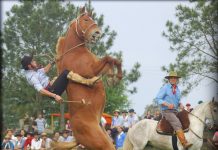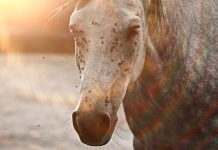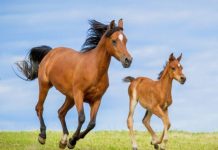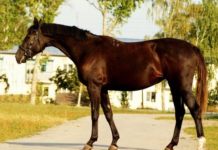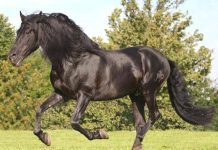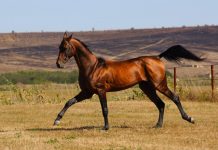The Paso Peruano is about 1.50 m tall and looks like a classy Andalusian or a fiery Berber. This is no wonder either because he emerged from these races.
What the tölt is for an Icelander, the Paso Llano is for the Paso Peruano: the fourth gait. The sparkling temperament of this horse contrasts with a noble gentleness.
This unique combination of seemingly opposing character traits is called “Brio” and is one of the special characteristics of the Paso Peruvian.
Breed description

The Paso Peruano is not as well known in Europe as the Icelander. There are also some differences in appearance and character.
What these two breeds have in common, however, is their fourth gait: in addition to walking, trot and canter, both have a fourth gait. With Icelanders this is called tölt, with Paso Peruano it is called Paso Llano.
Similar to the Icelander, the Paso Peruano was originally bred for bridging long distances in rough terrain. The Paso Llano made it much more comfortable for the rider to cover long distances.
Through targeted breeding, the position of the joints on the hindquarters of the Paso Peruanos was optimally matched to the Paso Llano. This gait is therefore innate in the horse.
Another special feature of these beautiful horses is a unique combination of seemingly opposing character traits, also known as “Brio”. The Paso Peruano is very spirited, fiery, elegant and proud.
At the same time, however, he is also sensitive, people-related, reliable and with strong nerves. This makes it the perfect horse for hiking and endurance rides, but it is also great as a leisure or dressage horse.
Size: 140-155 cm
Weight: 400 – 650 kg
Origin: Peru
Lifespan: 20-25 years
Color: All colors allowed. Piebalds are not allowed for breeding
Suitable as: Dressage, free time
Origin and breed history
The history of the Paso Peruano began with the conquest of South America by the Spaniards. They brought their Andalusians and a breed of Berber horses, the Genettes, with them to the new world.
The very rough terrain in South America made it necessary to breed the horses for a certain comfort, as they were mainly used to cover great distances and for war.
From this thought the requirement arose to breed a horse with natural tölt. In the mountains and in difficult terrain, canter was not an option, so the emphasis was on developing other gaits.
During the last century horses with an innate tendency to trot were rigorously excluded from breeding, so that the characteristic Paso Llano gained more and more weight.
The Paso Llano, which is typical for the Paso Peruano, is a relatively slow pace. Since it is of the opinion in Peru that the canter spoils the Paso Llano, galloping is avoided there.
In the Paso Llano, the front legs describe a semicircle out of the shoulder, the so-called termino, when viewed from the front. The four isochronous hoof beats are also characteristic.
The appearance of the Paso Peruano
The Paso Peruano reaches a height of 1.40 to 1.55 m, its head is dry, mostly slightly convex and expressive. The forehead is flat and relatively broad.
The ears are very fine and slightly curved inwards, the nostrils are large and flexible. The Paso Peruano has alert, expressive, slightly oval eyes. His neck is flexible and slim.
The mane and tail impress with their fine, but strongly pronounced, long hangings. The neck of the Paso Peruanos is set relatively high and strong.
He has a lot of belt depth and long, sloping shoulders. Its ribs are well arched and its loin area is pronounced. Its croup is slightly sloping and slightly lower than its withers. The back is rather short and relatively straight.
The horse’s tail is quite deep. The special angle of the joints on the legs, which makes the Paso Llano possible in the first place, is of particular importance. The hooves are small, hard, and well shaped.
The muscled legs are strong and long, the lower legs are dry and slender. The exterior of this beautiful horse is reminiscent of an Andalusian or a Berber. This is no wonder because the Paso Peruano has Iberian-African roots.
Temperament and essence

The essence of the Paso Peruanos amazes with its contrasts, which are also known as “Brio”. Hot-blooded and spirited horses can be seen in shows.
At the same time, this horse is wonderfully friendly and easy-going. In addition to being fiery, a Peruvian Paso is very gentle. The pretty horses impress with their pride and elegance and are just as people-centered and sensitive.
You are very interested and willing to work and want to learn. Due to their sensitive and reliable character, Paso Peruanos are the perfect companions for hiking and long-distance rides.
The Paso Peruano also wants to be challenged spiritually. Circular exercises, free work, and all kinds of floor work are fun for him. The Paso Peruano is wonderfully suitable as a therapy horse.
His empathetic manner and patience create trust immediately. But even if you are looking for a dressage horse or a leisure horse, you should definitely take a look at the Paso Peruano.
Husbandry and nutrition
Attitude
As a sturdy horse, the Paso Peruano is perfectly suited for open stables. He loves exercise and likes to be outside. When it gets cold in winter, he looks forward to a dry shelter or a place to sleep in a spacious box.
Horses are animals of movement. As such, they need to be able to move around freely and find their own food on a daily basis. Pastures with a varied vegetation of grass and herbs are ideal.
A salt lick should be available, as well as soil areas of different types. In summer, trees are important as shade providers. A suitable shelter should be available in winter or when there is strong wind or rain.
Freshwater is a matter of course. Often the conditions in a stable are not as optimal as described above. But that shouldn’t discourage you!
Look around your barn and the neighborhood. Perhaps many things can be easily complemented with a little creativity. This is even easier to do as a group.
Just swap the pastures of your horses. This is a great way to add variety to your daily grazing. And if there are no trees, get active yourself and build a shelter together.
Nutrition
The same applies to nutrition. The Paso Peruano needs a species-appropriate and varied feed. Like many herbivores, it is naturally preoccupied with eating for much of the day.
Grass, leaves, herbs, fruit, roots, shrubs, berries and seeds are part of a horse’s natural diet. There should therefore always be sufficient quantities of good hay available in the stable to nibble on.
Hay that is not contaminated by pesticides and that contains natural herbs would be ideal. If such hay is not available to you, you can add herbal mixtures.
When adding herbs to your diet, make sure you have a change! It is also important that your Paso Peruano does not have too long breaks between the individual meals.
As described above, horses eat a large part of the day when they are in their natural environment. The fact that under these conditions a few feedings per day with very large amounts of feed can be harmful for them is almost self-explanatory.
To keep your Paso Peruano healthy, it should be given several meals a day, not just one or two feedings in large quantities. If this is not feasible, you should make sure that he always finds fresh, clean straw to nibble on.
As a snack between meals or as a supplement, your Paso Peruano is happy to have carrots, sugar beets and apples. Fresh twigs also provide a welcome change. Make sure, however, that the trees are non-toxic to horses, such as fruit trees, birch or hazelnut.
Education and care
Upbringing
The Paso Peruano is gentle and sensitive. He can adapt very well to different people and is always a reliable partner. Of course, a sensitive horse needs appropriate training.
You should therefore deal with him consistently, but also sensitively. Do not ask anything from your Paso Peruano that it cannot afford. This would lead to frustration on both sides.
If you want to train him, be patient and assume that he will do everything possible to accommodate your needs. With a lot of love and patience you can achieve more with this sensitive, but also proud horse than with pressure.
Of course, there can also be situations in which you have to take decisive action. In such cases, you can address your Paso Peruano louder and more firmly. Tapping with a whip is also okay. Remember that your horse thinks differently from humans.
It can therefore do nothing with a punishment that does not directly follow its “offense”. Therefore, always make it clear to your horse immediately and lovingly what it should change.
The Paso Peruano is gentle and very intelligent. He loves to learn new things with you and likes to follow you.
Maintenance
Taking care of your horse is part of a healthy life. Often this is neglected because it is seen as time consuming and a necessary evil. Time to rethink. With the care you strengthen the connection between you and your Paso Peruano.
Take time every day to check their fur and hooves. You should always remove coarse dirt quickly, if necessary with water and a mild shampoo.
Then you remove dead skin and hair with the grooming and brushing and you also take care of the stimulation of the blood circulation. Pay particular attention to the hooves.
Many horses stand in damp straw for several hours a day. This puts a strain on the hooves, as does the mostly very similar floor covering on which they spend the whole day.
Check and clean the hooves of your Paso Peruano every day. The farrier should also check them every 6 to 8 weeks, cut them out and correct them if necessary.
Health and Typical Diseases
The Paso Peruano is a very robust horse. But robust horse breeds also need consistent and continuous care in order to stay healthy.
Daily grooming and hoof care should be a matter of course. Regular checks by the veterinarian and the farrier are also important.
In this way you can prevent possible health problems or nip them in the bud. The degenerative desmitis of the fetlock wearer (DSLD) became known through the Paso Peruano.
This illness results in pain, followed by lameness and ultimately death of the horse. Other horse breeds are also affected by this disease.
It is currently believed that the disease has a genetic component. Affected horses must be withdrawn from their tournament or show career prematurely. There are no remedies yet.
Life expectancy
Horses live between 18 and 30 years old, depending on the breed. Cold-blooded animals have the lowest life expectancy, ponies the highest. The Paso Peruano moves between these two extremes.
There is no precise information because age largely depends on the state of health, possible genetic impairments, and also on the entire living environment.
You can do a lot for your Paso Peruanos to an old age by loving care for them, developing them mentally and physically and by regularly introducing them to the vet and the farrier.
See what food is good for him and ensure plenty of exercise and fresh air. The contact with conspecifics is also very important.
Especially horses as herd animals do not like to stand alone in the meadow, but prefer to be outside in a group.
Buy Paso Peruano horse breed
In Europe, there are fewer breeders of the Paso Peruvian than in the USA or in South America. The first point of contact for information about the purchase of a Paso Peruanos was the association Paso Peruano Europa e.V., but it was decided to dissolve in 2018.
However, you can still find information about the Paso Peruano on the PPE website.
Also of interest is the website of the International Gan Horse Association, IGV, which provides a lot of information about gaited horses and also makes contact with breeders.
You may be interested in other thoroughbred species, such as the American Shetland Pony, Percheron, or Altwürttemberger.
Decision support

Your horse has to suit you. You should therefore first consider what you expect from your Paso Peruano.
Do you want to take part in shows? Do you want to win dressage tournaments? Are you looking for a recreational horse or do you want to breed? It is also important how your horse and riding knowledge and skills are developed.
It doesn’t help you if you buy a young and inexperienced horse if you don’t have a lot of experience yourself.
It is very helpful if you can ask an expert or at least a person with horse experience for support if you do not have the necessary knowledge and experience yourself.
Talk to the riding instructor or the vet. If they cannot help you directly, they will surely know someone who can help you find a suitable horse.








